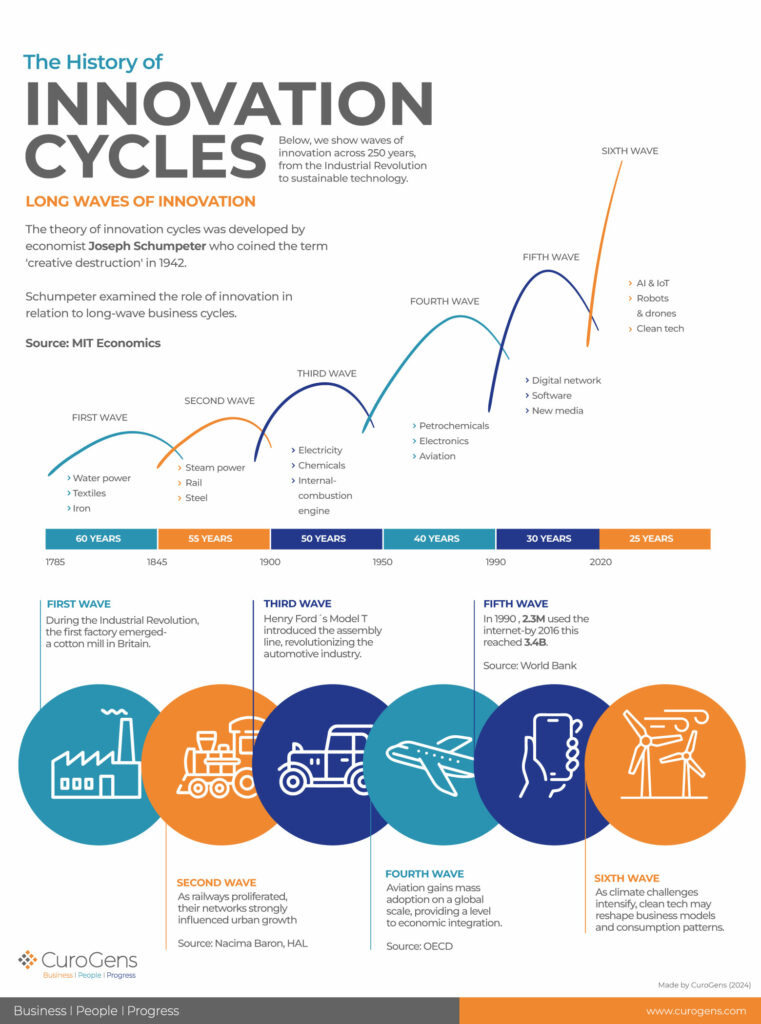Home Surfing the waves of innovation with CuroGens: An era of digital transformation
At the forefront of the innovation process, the innovation lifecycle stands out as a key pillar for companies seeking growth and adaptation. This blog delves into how CuroGens becomes a strategic ally, driving innovation strategy in the technological era.
We explore the role of CuroGens in driving lifecycle and innovation strategy for proactive companies.

Innovation has undergone a significant evolution over time. Since the early 1980s, there have been breaks in lapses of approximately five years, leading to a broader and more complex conception of innovation. It has gone from being a purely technological concept to encompass cultural, social and economic aspects. Innovation has become a key element for the development and success of organizations today.
Over the centuries, the phases of innovation have consistently transformed the fabric of society and the economy. Studying this phenomenon offers valuable insights into the Innovation vs. Invention debate.
Every business model faces the challenge of innovation adoption. Those that succeed in integrating it effectively distinguish themselves and lead in their respective fields.
The history of innovation underscores the importance of a robust strategy for business advancement.
Waves of innovation have become a frame of reference for understanding technological development cycles and their impact on society and the economy. CuroGens is positioned in the fifth and sixth waves of innovation, which are characterized by the adoption of technologies such as virtual reality, artificial intelligence, autonomous driving and sustainability.
In the fifth wave, CuroGens focuses on offering customizable and integrable business management solutions, empowering companies to adapt to technological changes and take advantage of the opportunities brought by digital transformation.
In the sixth wave, CuroGens aligns with sustainability principles and promotes a new way of thinking to continue innovating dynamically. It helps organizations align their strategy, model, culture and organizational structure with the principles of sustainability, generating positive impacts on society and the economy.
At the heart of the fifth and sixth wave, CuroGens offers solutions to take the Prototype and MVP (Minimum Viable Product) from concept to effective market implementation.
CuroGens highlights its effectiveness through implementing innovation strategies in small companies, and shows its capability in developing innovative products in competitive markets.
CuroGens plays a crucial role in digital transformation, fostering innovation and facilitating the transition from prototypes to successful commercial solutions.
The ERP (Enterprise Resource Planning) system plays a key role in business transformation. An ERP is a computer system that integrates and automates an organization’s business processes, such as inventory management, finance, human resources and sales. It aims to optimize operational efficiency, improve decision making and provide a holistic view of the enterprise.
The implementation of an ERP in a company allows centralizing and standardizing data, which facilitates collaboration and communication between different departments. It also provides a single platform for managing and analyzing business information, which helps to identify areas for improvement, optimize processes and make more informed decisions.
In the context of business transformation, an ERP enables organizations to adapt to technological changes and take advantage of the opportunities offered by digitalization. By integrating different areas and functions of the company, an ERP facilitates the automation of tasks, the optimization of workflows and the improvement of operational efficiency. It also provides a solid foundation for the implementation of emerging technologies, such as artificial intelligence and data analytics, which can drive business innovation and competitiveness.
ERP systems are crucial in the innovation phases, enabling companies to adapt and scale. CuroGens, with its deep expertise in Microsoft Dynamics, is positioned as a key enabler in this process, especially in the adoption of business management solutions.
ERP systems, such as those offered by CuroGens, are vital for companies looking to innovate and scale in today’s digital economy.
Digital innovation presents both challenges and opportunities for companies. In an increasingly digitized business environment, organizations face the challenge of adapting quickly to technological changes and taking advantage of the opportunities offered by digital innovation.
One of the key challenges is the need to keep up to date with the latest digital technologies and trends. This requires a mindset that is open to change and a business culture that encourages experimentation and adoption of new technologies. In addition, companies must overcome barriers such as resistance to change, lack of knowledge and lack of resources to fully implement and leverage digital technologies.
However, digital innovation also offers numerous opportunities for companies. It enables the creation of new business models, the improvement of customer experience, the optimization of internal processes and the generation of competitive advantages. The digitization of business processes can increase efficiency, reduce operating costs and improve data-driven decision making.
In addition, digital innovation opens up new market opportunities and enables companies to reach new customers and expand their global reach. The adoption of technologies such as artificial intelligence, data analytics, the cloud, and the Internet of Things can drive the adoption of new technologies.
The adoption of new technologies brings challenges; CuroGens offers expertise and resources to overcome common challenges in the innovation lifecycle, ensuring that companies not only survive, but thrive.
Successful examples of technology innovation adoption demonstrate how the right strategies can lead a company to success. CuroGens has become an ally for many companies in this journey.
CuroGens is a strategic partner for companies facing challenges in their innovation process, helping them to adopt new technologies effectively.
CuroGens exemplifies innovation adoption by extending its ERP solutions and digitization strategies to more than 30 countries, promoting significant change in the way companies manage their operations and growth strategies.
CuroGens leads innovation adoption globally, transforming the business model through advanced ERP solutions.
CuroGens solutions reflect the importance of a well-defined innovation strategy, facilitating the transition to digitalization and maximizing the potential of current and future innovation phases.
CuroGens is a key ally in improving the innovation lifecycle, offering solutions that prepare companies for the future
We invite companies to explore how CuroGens can be the ideal partner for developing innovative products in competitive markets and overcoming common challenges in the innovation lifecycle.
We are here to help you.
Contact us and we’ll get back to you with relevant information about our solutions and services.
Our specialist consulting team is looking forward to hearing from you!

We are here to help you.
Contact us and we’ll get back to you with relevant information about our solutions and services.
Our specialist consulting team is looking forward to hearing from you!

In accordance with the RGPD and the LOPDGDD, CUROGENS. will treat the data provided, in order to answer the questions and/or complaints raised through this form and provide the requested information. Provided that you previously authorize it, we will send information related to the services offered by CUROGENS. and the rest of the CUROGENS GROUP. You may exercise, if you wish, the rights of access, rectification, deletion, and others recognized in the aforementioned regulations. To obtain more information about how we are treating your data, access our privacy policy.